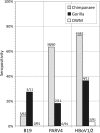Widespread infection with homologues of human parvoviruses B19, PARV4, and human bocavirus of chimpanzees and gorillas in the wild
- PMID: 20668071
- PMCID: PMC2937811
- DOI: 10.1128/JVI.01304-10
Widespread infection with homologues of human parvoviruses B19, PARV4, and human bocavirus of chimpanzees and gorillas in the wild
Abstract
Infections with human parvoviruses B19 and recently discovered human bocaviruses (HBoVs) are widespread, while PARV4 infections are transmitted parenterally and prevalent specifically in injecting drug users and hemophiliacs. To investigate the exposure and circulation of parvoviruses related to B19 virus, PARV4, and HBoV in nonhuman primates, plasma samples collected from 73 Cameroonian wild-caught chimpanzees and gorillas and 91 Old World monkey (OWM) species were screened for antibodies to recombinant B19 virus, PARV4, and HBoV VP2 antigens by enzyme-linked immunosorbent assay (ELISA). Moderate to high frequencies of seroreactivity to PARV4 (63% and 18% in chimpanzees and gorillas, respectively), HBoV (73% and 36%), and B19 virus (8% and 27%) were recorded for apes, while OWMs were uniformly negative (for PARV4 and B19 virus) or infrequently reactive (3% for HBoV). For genetic characterization, plasma samples and 54 fecal samples from chimpanzees and gorillas collected from Cameroonian forest floors were screened by PCR with primers conserved within Erythrovirus, Bocavirus, and PARV4 genera. Two plasma samples (chimpanzee and baboon) were positive for PARV4, while four fecal samples were positive for HBoV-like viruses. The chimpanzee PARV4 variant showed 18% and 15% nucleotide sequence divergence in NS and VP1/2, respectively, from human variants (9% and 7% amino acid, respectively), while the baboon variant was substantially more divergent, mirroring host phylogeny. Ape HBoV variants showed complex sequence relationships with human viruses, comprising separate divergent homologues of HBoV1 and the recombinant HBoV3 species in chimpanzees and a novel recombinant species in gorillas. This study provides the first evidence for widespread circulation of parvoviruses in primates and enables future investigations of their epidemiology, host specificity, and (co)evolutionary histories.
Figures



References
Publication types
MeSH terms
Associated data
- Actions
- Actions
- Actions
- Actions
- Actions
- Actions
- Actions
- Actions
- Actions
Grants and funding
LinkOut - more resources
Full Text Sources
Research Materials
Miscellaneous

